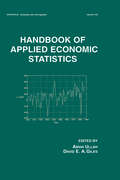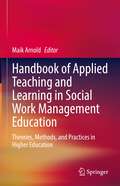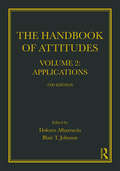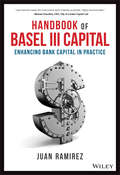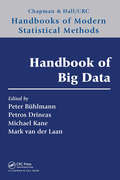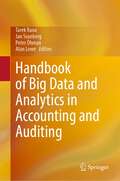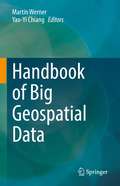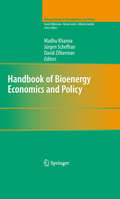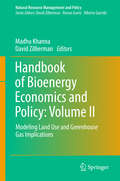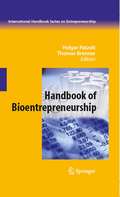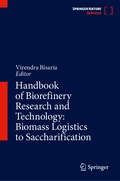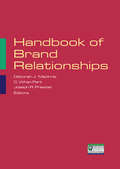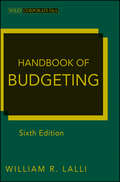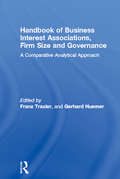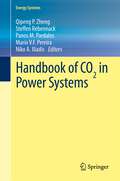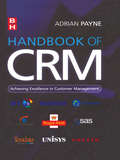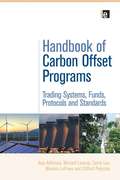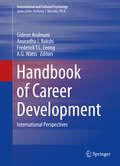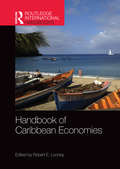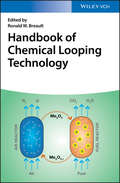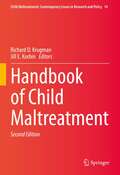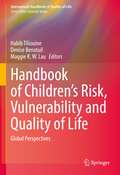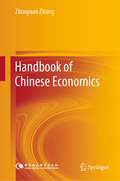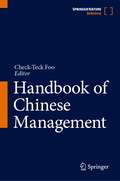- Table View
- List View
Handbook of Applied Economic Statistics (Statistics: A Series of Textbooks and Monographs)
by Aman Ullah David E. A. GilesThis work examines theoretical issues, as well as practical developments in statistical inference related to econometric models and analysis. This work offers discussions on such areas as the function of statistics in aggregation, income inequality, poverty, health, spatial econometrics, panel and survey data, bootstrapping and time series.
Handbook of Applied Teaching and Learning in Social Work Management Education: Theories, Methods, and Practices in Higher Education
by Maik ArnoldThis up-to-date reference work explores theories, methods and practices of social work management education in higher education. It includes contributions from more than 30 scholars and researchers in the field of social work management education from more than 10 countries and 4 continents.The work is unique as it overcomes current barriers between the different sub-disciplines of social work didactics and management education, and takes into consideration the development of a discipline-specific Scholarship of Teaching and Learning (SoTL). The integrated and transdisciplinary approach to social work management education presented in this edited volume is of paramount importance to international scholars, teachers, practitioners, students and all other audiences interested in the field of education. The work provides an overview of the theoretical principles on how social work management can be taught and learned, and analyzes curricula, pedagogical approaches, actors, and socio-economic and institutional contexts of social work management at higher education institutions
Handbook of Attitudes, Volume 2: 2nd Edition
by Dolores Albarracin Blair T. JohnsonAttitudes are evaluations of people, places, things, and ideas. They help us to navigate through a complex world. They provide guidance for decisions about which products to buy, how to travel to work, or where to go on vacation. They color our perceptions of others. Carefully crafted interventions can change attitudes and behavior. Yet attitudes, beliefs, and behavior are often formed and changed in casual social exchanges. The mere perception that other people—say, rich people— favor something may be sufficient to make another person favor it. People’s own actions also influence their attitudes, such that they adjust to be more supportive of the actions. People’s belief systems even change to align with and support their preferences, which at its extreme is a form of denial for which people lack awareness. These two volumes of The Handbook of Attitudes provide authoritative, critical surveys of theory and research about attitudes, beliefs, persuasion, and behavior from key authors in these areas. This second volume covers applications to measurement, behavior prediction, and interventions in the areas of cancer, HIV, substance use, diet, and exercise, as well as in politics, intergroup relations, aggression, migrations, advertising, accounting, education, and the environment.
Handbook of Basel III Capital - Enhancing Bank Capital in Practice
by Juan RamirezA deeper examination of Basel III for more effective capital enhancement The Handbook of Basel III Capital – Enhancing Bank Capital in Practice delves deep into the principles underpinning the capital dimension of Basel III to provide a more advanced understanding of real-world implementation. Going beyond the simple overview or model, this book merges theory with practice to help practitioners work more effectively within the regulatory framework, and utilise the complex rules to more effectively allocate and enhance capital. A European perspective covers the CRD IV directive and associated guidance, but practitioners across all jurisdictions will find value in the strategic approach to decisions surrounding business lines and assets; an emphasis on analysis urges banks to shed unattractive positions and channel capital toward opportunities that actually fit their risk and return profile. Real-world cases demonstrate successful capital initiatives as models for implementation, and in-depth guidance on Basel III rules equips practitioners to more effectively utilise this complex regulatory treatment. The specifics of Basel III implementation vary, but the underlying principles are effective around the world. This book expands upon existing guidance to provide a deeper working knowledge of Basel III utility, and the insight to use it effectively. Improve asset quality and risk and return profiles Adopt a strategic approach to capital allocation Compare Basel III implementation varies across jurisdictions Examine successful capital enhancement initiatives from around the world There is a popular misconception about Basel III being extremely conservative and a deterrent to investors seeking attractive returns. In reality, Basel III presents both the opportunity and a framework for banks to improve their assets and enhance overall capital – the key factor is a true, comprehensive understanding of the regulatory mechanisms. The Handbook of Basel III Capital – Enhancing Bank Capital in Practice provides advanced guidance for advanced practitioners, and real-world implementation insight.
Handbook of Big Data (Chapman & Hall/CRC Handbooks of Modern Statistical Methods)
by Michael Kane Peter Bühlmann Petros Drineas Mark van der LaanHandbook of Big Data provides a state-of-the-art overview of the analysis of large-scale datasets. Featuring contributions from well-known experts in statistics and computer science, this handbook presents a carefully curated collection of techniques from both industry and academia. Thus, the text instills a working understanding of key statistical
Handbook of Big Data and Analytics in Accounting and Auditing
by Tarek Rana Jan Svanberg Peter Öhman Alan Lowe<p>This handbook collects the most up-to-date scholarship, knowledge, and new developments of big data and data analytics by bringing together many strands of contextual and disciplinary research. In recent times, while there has been considerable research in exploring the role of big data, data analytics, and textual analytics in accounting, and auditing, we still lack evidence on what kinds of best practices academics, practitioners, and organizations can implement and use.<p> <p>To achieve this aim, the handbook focuses on both conventional and contemporary issues facing by academics, practitioners, and organizations particularly when technology and business environments are changing faster than ever. All the chapters in this handbook provide both retrospective and contemporary views and commentaries by leading and knowledgeable scholars in the field, who offer unique insights on the changing role of accounting and auditing in today’s data and analytics driven environment.<p>
Handbook of Big Geospatial Data
by Martin Werner Yao-Yi ChiangThis handbook covers a wide range of topics related to the collection, processing, analysis, and use of geospatial data in their various forms. This handbook provides an overview of how spatial computing technologies for big data can be organized and implemented to solve real-world problems. Diverse subdomains ranging from indoor mapping and navigation over trajectory computing to earth observation from space, are also present in this handbook. It combines fundamental contributions focusing on spatio-textual analysis, uncertain databases, and spatial statistics with application examples such as road network detection or colocation detection using GPUs. In summary, this handbook gives an essential introduction and overview of the rich field of spatial information science and big geospatial data. It introduces three different perspectives, which together define the field of big geospatial data: a societal, governmental, and governance perspective. It discusses questions of how the acquisition, distribution and exploitation of big geospatial data must be organized both on the scale of companies and countries. A second perspective is a theory-oriented set of contributions on arbitrary spatial data with contributions introducing into the exciting field of spatial statistics or into uncertain databases. A third perspective is taking a very practical perspective to big geospatial data, ranging from chapters that describe how big geospatial data infrastructures can be implemented and how specific applications can be implemented on top of big geospatial data. This would include for example, research in historic map data, road network extraction, damage estimation from remote sensing imagery, or the analysis of spatio-textual collections and social media. This multi-disciplinary approach makes the book unique.This handbook can be used as a reference for undergraduate students, graduate students and researchers focused on big geospatial data. Professionals can use this book, as well as practitioners facing big collections of geospatial data.
Handbook of Bioenergy Economics and Policy
by David Zilberman Madhu Khanna Jürgen ScheffranConcerns about energy security, uncertainty about oil prices, declining oil reserves, and global climate change are fueling a shift towards bioenergy as a renewable alternative to fossil fuels. Public policies and private investments around the globe are aiming to increase local capacity to produce biofuels. A key constraint to the expansion of biofuel production is the limited amount of land available to meet the needs for fuel, feed, and food in the coming decades. Large-scale biofuel production raises concerns about food versus fuel tradeoffs, about demands for natural resources such as water, and about potential impacts on environmental quality. The book is organized into five parts. The introductory part provides a context for the emerging economic and policy challenges related to bioenergy and the motivations for biofuels as an energy source. The second part of the handbook includes chapters that examine the implications of expanded production of first generation biofuels for the allocation of land between food and fuel and for food/feed prices and trade in biofuels as well as the potential for technology improvements to mitigate the food vs. fuel competition for land. Chapters in the third part examine the infrastructural and logistical challenges posed by large scale biofuel production and the factors that will influence the location of biorefineries and the mix of feedstocks they use. The fourth part includes chapters that examine the environmental implications of biofuels, their implications for the design of policies and the unintended environmental consequences of existing biofuel policies. The final part presents economic analysis of the market, social welfare, and distributional effects of biofuel policies.
Handbook of Bioenergy Economics and Policy: Volume II
by David Zilberman Madhu KhannaIn its second volume, this book aims to link the academic research with development in the real world and provide a historical and institutional background that can enrich more formal research. The first section will include an assessment of the evolution and the state of the nascent second-generation biofuel as well as a perspective on the evolution of corn ethanol and sugarcane ethanol in Brazil. It will also include a historical and institutional background on the biofuel industry in Brazil that has global lessons, and later, provide a technical overview of major analytical tools used to assess the economic, land use and greenhouse gas implications of biofuel policies at a regional and global level. Additionally, the book analyzes the various drivers for land use change both at a micro-economic level and at a macro-economic level. It presents studies that apply regional and global economic models to examine the effects of biofuel policies in the US, EU and Brazil on regional and global land use, on food and fuel prices and greenhouse gas emissions. These papers illustrate the use of partial and general equilibrium modeling approaches to simulate the effects of various biofuel policies, and includes studies showing the effects of risk aversion, time preferences and liquidity constraints on farmers decision to grow energy crops for biofuel production. By presenting the tools of lifecycle analysis for assessing the direct greenhouse gas intensity of biofuels, this handbook investigates the types of indirect or market mediated effects that can offset or strengthen these direct effects. It will include tools to assess the direct and indirect effects of biofuel production on greenhouse gas emissions in the US and Brazil, and ultimately provide a comprehensive background to understand the state of biofuel in the present and how to analyze their implication.
Handbook of Bioentrepreneurship
by Holger Patzelt Thomas BrennerProviding an important and timely overview of research on the exciting area of entrepreneurship in biotechnology, The Handbook of Bioentrepreneurship examines one of the most promising industries of the 21st century. While genetically engineered food and biopharmaceuticals have made biotechnology part of our everyday life, starting a bioventure is among the most complex and risky entrepreneurial tasks given long development cycles, high technological and market uncertainty, and high capital intensity. Providing unparalleled in-depth and detailed analysis, this Handbook sheds light on business models and strategies, financing, cooperation networks between firms and universities, among other issues. With new developments in biotechnology increasingly in the news, this is an important source for readers interested in public policy, entrepreneurship, and business in the 21st century.
Handbook of Biorefinery Research and Technology: Biomass Logistics to Saccharification
by Virendra BisariaThis handbook provides a comprehensive review of the latest scientific developments through authoritative, expertly validated overviews in this field. It covers the basic principles, upfront research accomplishments as well as successful industrial applications. Each chapter is written by a domain expert which besides the in-depth review of the topic also outlines an economic outlook and future directions of research of the area. The book is structured in a way that is appropriate for advanced graduate students and professionals in diverse scientific and engineering communities including biocatalysis, genetic engineering, metabolic engineering, and bioprocess technology.
Handbook of Biorefinery Research and Technology: Production of Biofuels and Biochemicals
by Virendra BisariaThis handbook provides a comprehensive review of the latest scientific developments through authoritative, expertly validated overviews in this field. It covers the basic principles, upfront research accomplishments as well as successful industrial applications. Each chapter is written by a domain expert which besides the in-depth review of the topic also outlines an economic outlook and future directions of research of the area. The book is structured in a way that is appropriate for advanced graduate students and professionals in diverse scientific and engineering communities including biocatalysis, genetic engineering, metabolic engineering, and bioprocess technology.
Handbook of Brand Relationships
by C. Whan Park Deborah J. MacInnis Joseph W. PriesterBrand relationships are critical because they can enhance company profitability by lowering customer acquisition and retention costs. This is the first serious academic book to offer a psychological perspective on the meaning of and basis for brand relationships, as well as their effects. "The Handbook of Brand Relationships" includes chapters by well-known marketing and psychology scholars on topics related to the meaning, significance, and measurement of brand relationships; the critical connections between consumers and the brand; how brand relationships are formed through both thoughtful and non-thoughtful processes; and how they are built, repaired, and leveraged through brand extensions. An integrative framework introduces the book and summarizes the chapters' key ideas. The handbook also identifies several novel metrics for measuring various aspects of brand relationships, and it includes recommendations for further research.
Handbook of Budgeting (Wiley Corporate F&a Ser. #562)
by William R. LalliNo other management tool provides the operational direction that a well-planned budget can. Now in a new edition, this book provides updated coverage on issues such as budgeting for exempt organizations and nonprofits in light of the IRS' newly issued Form 990; what manufacturing CFOs' budgeting needs are; current technology solutions; and updated information on value-based budgets. Controllers, budget directors, and CFOs will benefit from this practical "how-to" book's coverage, from the initial planning process to forecasting to specific industry budgets.
Handbook of Business Interest Associations, Firm Size and Governance: A Comparative Analytical Approach
by Franz Traxler Gerhard HuemerThis Handbook presents a theory of Business Interest Associations and fifteen empirical country by country case studies in the EU. The book is organized into three main parts. Part I develops a theory of business associations which centres on firm size as the key explanatory variable. Part II consists of country studies covering the EU-15, which are written along strictly comparable lines of analysis. Part III contains the cross-nationally comparative analysis. The book will make essential reading for researchers working in organization studies, industrial relations, industrial sociology and political science, as well as practioners in related fields.
Handbook of CO₂ in Power Systems
by Panos M. Pardalos Niko A. Iliadis Mario V. Pereira Steffen Rebennack Qipeng P. ZhengThe Handbook of CO in Power Systems' objective is to include the state-of-the-art developments that occurred in power systems taking CO emission into account. The book includes power systems operation modeling with CO emissions considerations, CO market mechanism modeling, CO regulation policy modeling, carbon price forecasting, and carbon capture modeling. For each of the subjects, at least one article authored by a world specialist on the specific domain is included.
Handbook of CRM: Achieving Excellence In Customer Management
by Adrian PayneCustomer Relationship Management is a holistic strategic approach to managing customer relationships to increase shareholder value, and this major Handbook of CRM gives complete coverage of the key concepts in this vital field. It is about achieving a total understanding of the concepts that underlie successful CRM rather than the plethora of systems that can be used to implement it.Based on recent knowledge, it is underpinned by:* Clear and comprehensive explanations of the key concepts in the field* Vignettes and full cases from major businesses internationally* Definitive references and notes to further sources of information on every aspect of CRM* Templates and audit advice for assessing your own CRM needs and targetsThe most lucid, comprehensive and important overview of the subject and an invaluable tool in enabling the connection of the major principles to the real world of business.
Handbook of Carbon Offset Programs: Trading Systems, Funds, Protocols and Standards (Environmental Market Insights)
by Carrie Lee Anja Kollmuss Michael Lazarus Maurice LeFranc Clifford PolycarpGreenhouse gas (GHG) offsets have long been promoted as an important element of a comprehensive climate policy approach. Offset programs can reduce the overall cost of achieving a given emission goal by enabling emission reductions to occur where costs are lower. Offsets have the potential to deliver sustainability co-benefits, through technology development and transfer. They can also develop human and institutional capacity for reducing emissions in sectors and locations not included in a cap and trade or a mandatory government policy. However, offsets can pose a risk to the environmental integrity of climate actions, especially if issues surrounding additionality, permanence, leakage, quantification and verification are not adequately addressed. The challenge is to design offset programs and policies that can maximize their potential benefits while minimizing their potential risks. This handbook provides a systematic and comprehensive review of existing offset programs. It looks at what offsets are, how offset mechanisms function, and the successes and pitfalls they have encountered. Coverage includes offset programs across the full swath of applications including mandatory and voluntary systems, government regulated and private markets, carbon offset funds, and accounting and reporting protocols such as the WBCSD/WRI GHG Protocol and ISO 14064. Learning from the successes and failures of these programs will be essential to crafting effective climate policy. This is an essential reference for all regulators, policy makers, business leaders and NGOs concerned with the design and operation of GHG offset programs world-wide. Published with SEI
Handbook of Career Development
by Gideon Arulmani Anuradha J. Bakshi Frederick T. L. Leong A. G. WattsThis book is focused on work, occupation and career development: themes that are fundamental to a wide range of human activities and relevant across all cultures. Yet theorizing and model building about this most ubiquitous of human activities from international perspectives have not been vigorous. An examination of the literature pertaining to career development, counseling and guidance that has developed over the last fifty years reveals theorizing and model building have been largely dominated by Western epistemologies, some of the largest workforces in the world are in the developing world. Career guidance is rapidly emerging as a strongly felt need in these contexts. If more relevant models are to be developed, frameworks from other cultures and economies must be recognized as providing constructs that would offer a deeper understanding of career development. This does not mean that existing ideas are to be discarded. Instead, an integrative approach that blends universal principles with particular needs could offer a framework for theorizing, research and practice that has wider relevance. The central objective of this handbook is to draw the wisdom and experiences of different cultures together to consider both universal and specific principles for career guidance and counseling that are socially and economically relevant to contemporary challenges and issues. This book is focused on extending existing concepts to broader contexts as well as introducing new concepts relevant to the discipline of career guidance and counseling.
Handbook of Caribbean Economies (Routledge International Handbooks)
by Robert E. LooneyThis volume aims to illustrate the uniqueness of the economies of the countries and territories of the Caribbean as well as the similarities they share with other regions. While most countries in the region share many of the characteristics of middle-income countries, theirs is a matter of extremes. Their generally small size suggests a fragility not found elsewhere. While much of the world is beginning to feel some effects of climate change, the Caribbean is ground zero. These factors suggest a difficult road ahead, but the chapters presented in this volume aim to help to spur the search for creative solutions to the region’s problems. The chapters, written by expert contributors, examine the Caribbean economies from several perspectives. Many break new ground in questioning past policy mindsets, while developing new approaches to many of the traditional constraints limiting growth in the region. The volume is organized in four sections. Part I examines commonalities, including issues surrounding small economies, tourism, climate change and energy security. Part II looks at obstacles to sustained progress, for example debt, natural disasters and crime. In Part III chapters consider the specific role of external influences, including the USA and the European Union, the People's Republic of China, as well as regional co-operation. The volume concludes in Part IV with country case studies intended to provide a sense of the diversity that runs through the region.
Handbook of Chemical Looping Technology
by Ronald W. BreaultThis comprehensive and up-to-date handbook on this highly topical field, covering everything from new process concepts to commercial applications. Describing novel developments as well as established methods, the authors start with the evaluation of different oxygen carriers and subsequently illuminate various technological concepts for the energy conversion process. They then go on to discuss the potential for commercial applications in gaseous, coal, and fuel combustion processes in industry. The result is an invaluable source for every scientist in the field, from inorganic chemists in academia to chemical engineers in industry.
Handbook of Child Maltreatment (Child Maltreatment #14)
by Richard D. Krugman Jill E. KorbinThe second edition of this successful handbook, edited by well-known experts in this field, includes core questions in the field of child abuse and neglect. It addresses major challenges in child maltreatment work, starting with “What is child abuse and neglect?” and then examines why maltreatment occurs and what are its consequences. The handbook also addresses prevention, intervention, investigation, treatment as well as civil and criminal legal perspectives. It comprehensively studies the issue from the perspective of a broader, international and cross-cultural human experience. Apart from a thorough revision of existing chapters, this edition includes many new chapters covering recent developments in this area and other issues not covered in the first edition. There is more focus on substance abuse, psychological abuse, and on social and community involvement and public health provisions in the prevention of child maltreatment. The handbook examines what is known now and more importantly what remains to be researched in the coming decades to help abused and neglected children, their families and their communities, thereby taking the field forward.
Handbook of Children’s Risk, Vulnerability and Quality of Life: Global Perspectives (International Handbooks of Quality-of-Life)
by Habib Tiliouine Maggie K. W. Lau Denise BenatuilThis handbook makes a major contribution to the growing international research and policy interest in children’s experienced well-being or quality of life in childhood, linking it to ongoing research on children’s risk and vulnerability. The editors and contributors adopt the broader concept of ‘risk’ in addition to ‘vulnerability’. Not much work considers the connections between risks that children experience and their quality of life. In examining children’s quality of life, the chapters discuss various issues of risk and vulnerability that may affect their lives and also how the quality of childhood might be enhanced and maintained even in the face of these factors. The chapters discuss experiences of violence and abuse; access to basic services such as housing, health and education; and children’s vulnerability due to broader external factors such as war, conflict, and environmental events. The volume also includes the impacts of new technologies on children and the consequent risks and vulnerabilities they may face, alongside the benefits.This important volume brings together a diverse range of perspectives from established experts and emerging scholars in these fields of work. It covers a wide range of geographical and cultural contexts, and includes theoretical, empirical, policy and practice-based contributions. This handbook is a natural first point of reference for academics and policy professionals interested in quality of life, well-being, and children's rights.
Handbook of Chinese Economics
by Zhuoyuan ZhangThis book reviews the development of Chinese economics since the reform and opening-up, associated with the history and experience of China's economic growth. This book makes a systematic study of the direction of reform, the method of reform, the path of reform, the main body of reform and the motive force of reform, accumulates more experiences that can be used for reference for the exploration of new reforms to be opened, and probes into the way of reform in the next period. The topics cover all key concepts and theories relating to the China's economic reform.
Handbook of Chinese Management
by Check-Teck FooThis handbook explores the theme of managing inside China and consists of chapters that communicate the major managerial concepts within the context of Mainland China. Its key emphasis is to clearly highlight the differences in the art of managing in China vs. the West, while acknowledging that these differences may be narrowing as a result of globalization. Chapters in the book elaborate on how management is affected as China experiences rapid change while some aspects of Chinese culture remain unchanged and steeped in tradition. The book goes further in exploring this complexity by juxtaposing China’s orientation towards interpersonal relations, or "guanxi", with the government’s emphasis on law, which is now becoming more rule-based than before. Business & Management academics and practitioners will gain useful insight into Chinese management practices and their contrast to established Western ones when they use the Handbook of Chinese Management as a reference.
